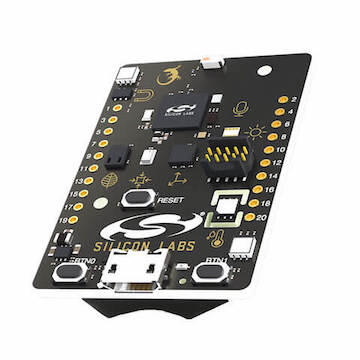EFR32MG12 Thunderboard (SLTB004A)
Overview
The EFR32MG12 Thunderboard (a.k.a Thunderboard Sense 2) contains an MCU from the EFR32MG12 family built on ARM® Cortex®-M4F processor with low power capabilities.

Hardware
EFR32MG12 Mighty Gecko Wireless SoC with 38.4 MHz operating frequency
ARM® Cortex® M4 core with 256 kB RAM and 1024 kB Flash
Macronix ultra low power 8-Mbit SPI flash (MX25R8035F)
2.4 GHz ceramic antenna for wireless transmission
Silicon Labs Si7021 relative humidity and temperature sensor
Silicon Labs Si1133 UV index and ambient light sensor
Silicon Labs Si7210 hall effect sensor
Bosch Sensortec BMP280 barometric pressure sensor
ams CCS811 indoor air quality gas sensor
TDK InvenSense ICM-20648 6-axis inertial sensor
TDK InvenSense ICS-43434 MEMS microphone
Four high brightness RGB LEDs from Broadcom Limited (ASMT-YTB7-0AA02)
One bi-color LED and two push buttons
Power enable signals for fine grained power-control
On-board SEGGER J-Link debugger for easy programming and debugging, which includes a USB virtual COM port
Mini Simplicity connector for access to energy profiling and advanced wireless network debugging
Breakout pads for GPIO access and connection to external hardware
Reset button
Automatic switch-over between USB and battery power
CR2032 coin cell holder and external battery connector
For more information about the EFR32MG12 SoC and Thunderboard Sense 2 board:
Supported Features
The sltb004a board configuration supports the following hardware features:
Interface |
Controller |
Driver/Component |
|---|---|---|
MPU |
on-chip |
memory protection unit |
NVIC |
on-chip |
nested vector interrupt controller |
SYSTICK |
on-chip |
systick |
COUNTER |
on-chip |
rtcc |
FLASH |
on-chip |
flash memory |
GPIO |
on-chip |
gpio |
UART |
on-chip |
serial port-polling; serial port-interrupt |
I2C |
on-chip |
i2c port-polling |
SPI(M) |
on-chip |
spi port-polling |
WATCHDOG |
on-chip |
watchdog |
TRNG |
on-chip |
true random number generator |
The default configuration can be found in boards/silabs/dev_kits/sltb004a/sltb004a_defconfig
Other hardware features are currently not supported by the port.
Connections and IOs
The EFR32MG12 SoC has eight gpio controllers (PORTA, PORTB, PORTC, PORTD, PORTF, PORTI, PORTJ and PORTK).
In the following table, the column Name contains Pin names. For example, PE2 means Pin number 2 on PORTE and #27 represents the location bitfield , as used in the board’s and microcontroller’s datasheets and manuals.
Name |
Function |
Usage |
|---|---|---|
PD8 |
GPIO |
LED0 (RED) |
PD9 |
GPIO |
LED1 (GREEN) |
PD14 |
GPIO |
SW0 Push Button PB0 |
PD15 |
GPIO |
Push Button PB1 |
PA0 |
UART_TX |
UART TX Console VCOM_TX US0_TX #0 |
PA1 |
UART_RX |
UART RX Console VCOM_RX US0_RX #0 |
PF3 |
UART_TX |
EXP12_UART_TX LEU0_TX #27 |
PF4 |
UART_RX |
EXP14_UART_RX LEU0_RX #27 |
PC10 |
I2C_SDA |
EXP16_I2C_SDA I2C0_SDA #15 |
PC11 |
I2C_SCL |
EXP15_I2C_SCL I2C0_SCL #15 |
PB6 |
I2C_SDA |
CCS811_I2C_SDA I2C1_SDA #6 |
PB7 |
I2C_SCL |
CCS811_I2C_SCL I2C1_SCL #6 |
PK0 |
SPI_MOSI |
Flash MOSI US2_TX #29 |
PK2 |
SPI_MISO |
Flash MISO US2_RX #30 |
PF7 |
SPI_SCLK |
Flash SCLK US2_CLK #18 |
PK1 |
SPI_CS |
Flash Chip Select (GPIO) |
System Clock
The EFR32MG12 SoC is configured to use the 38.4 MHz external oscillator on the board.
Serial Port
The EFR32MG12 SoC has four USARTs and one Low Energy UARTs (LEUART with 9600 maximum baudrate). USART0 is configured as the Zephyr console and is connected to the On-Board J-Link Debugger that presents a virtual COM port for general purpose application serial data transfer with this interface.
Programming and Debugging
Note
Before using the kit the first time, you should update the J-Link firmware from J-Link-Downloads
Flashing
The SLTB004A includes an J-Link serial and debug adaptor built into the board. The adaptor provides:
A USB connection to the host computer, which exposes a Mass Storage and a USB Serial Port.
A Serial Flash device, which implements the USB flash disk file storage.
A physical UART connection which is relayed over interface USB Serial port.
Flashing an application to SLTB004A
The sample application Hello World is used for this example. Build the Zephyr kernel and application:
# From the root of the zephyr repository
west build -b sltb004a samples/hello_world
Connect the SLTB004A to your host computer using the USB port and you should see a USB connection which exposes a Mass Storage (TB004) and a USB Serial Port. Copy the generated zephyr.bin in the SLTB004A drive.
Open a serial terminal (minicom, putty, etc.) with the following settings:
Speed: 115200
Data: 8 bits
Parity: None
Stop bits: 1
Reset the board and you should be able to see on the corresponding Serial Port the following message:
Hello World! sltb004a